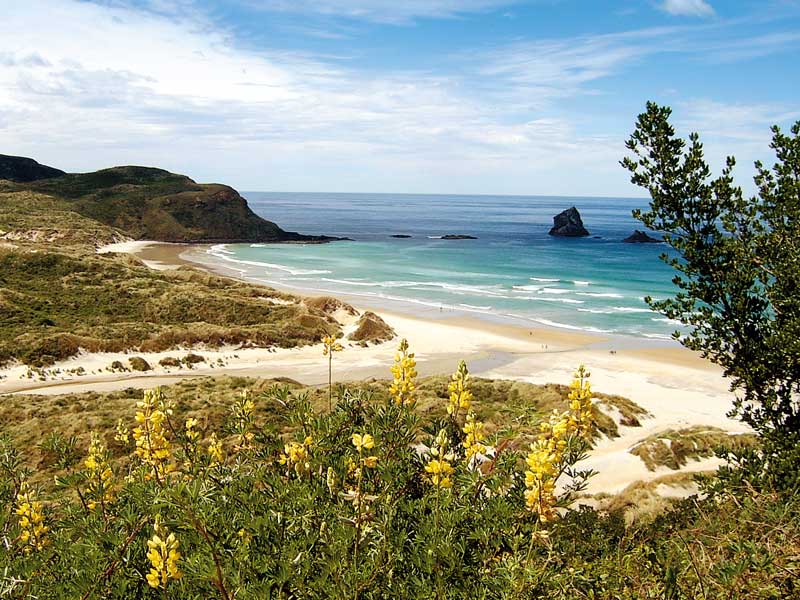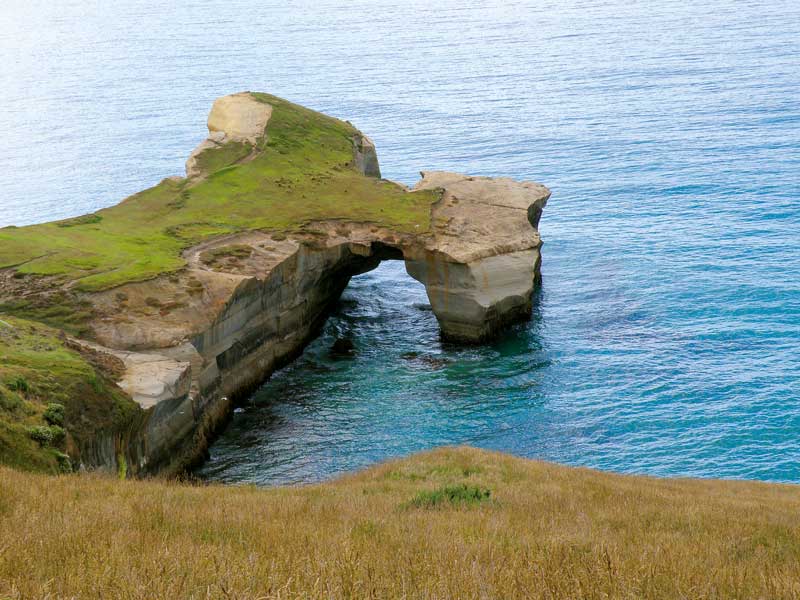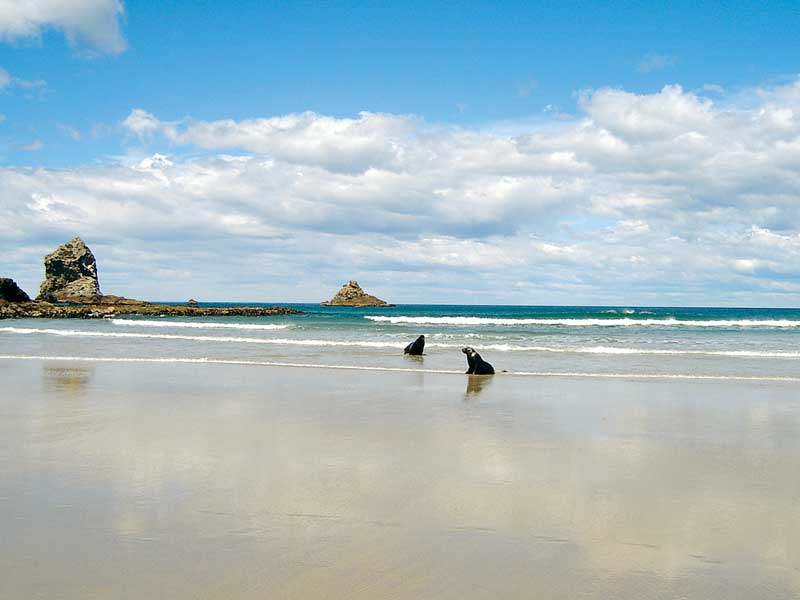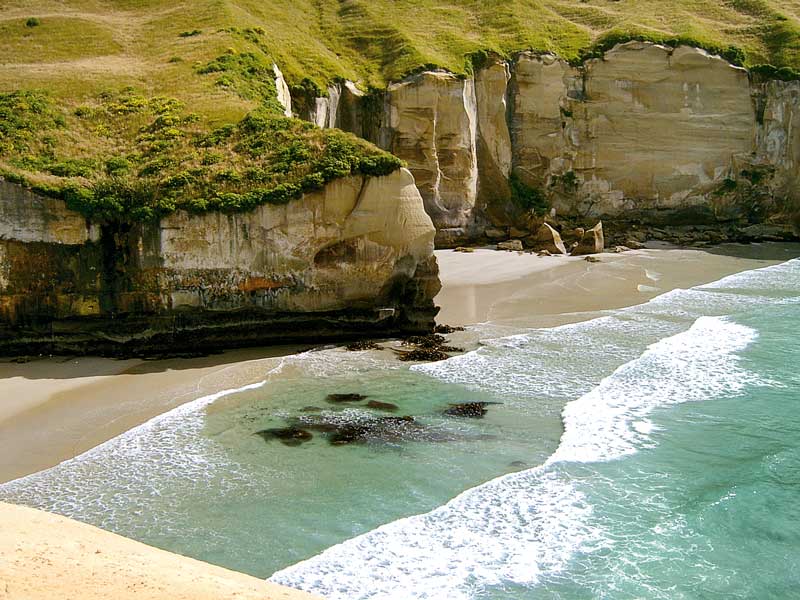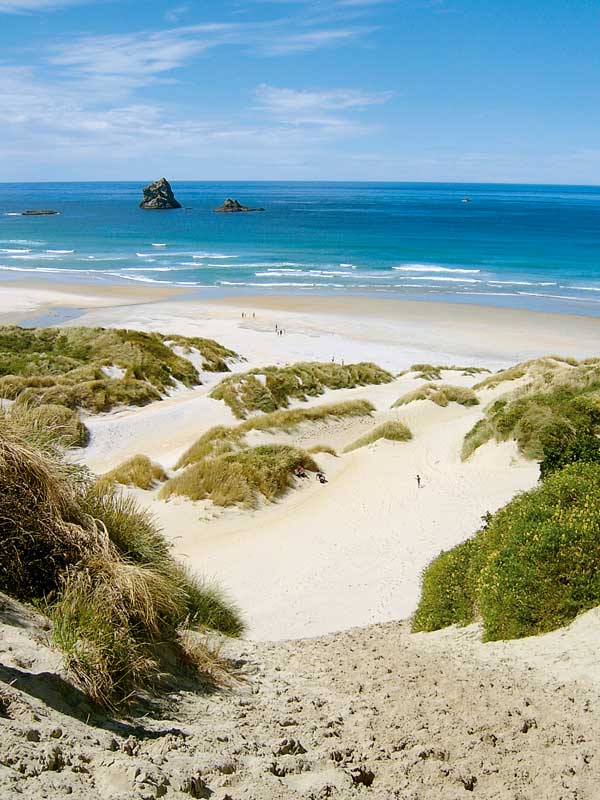Tunnel Beach has it all. Not only golden sand and clear water but you get to it through a tunnel, hand-carved through the rock of the cliffs. The walk down to Tunnel Beach from the car park is stunning in itself – there are views down to coastal stacks and a huge natural arch.
Then there’s the difficult choice – do we go down the tunnel first or go up onto the arch?
We chose the arch and were rewarded by views of pristine golden sandy beaches and clear blue water, with long views down the coast. Then for the tunnel – through a small arch and down 72 steps – and finally out from the dark into dazzling daylight, our own private beach.
It was in the 1870s that the Cargill family had the tunnel built. Captain William Cargill was the Presbyterian Scotsman instrumental in setting up the Free Church settlement of Otago. His son, the politician John Cargill, gave Tunnel Beach to his daughter as a birthday present.
After spending time in Dunedin we had decided to explore the Otago Peninsula and Tunnel Beach was a great place to start. Although not strictly on the Peninsula, it was on the route between where we had parked our bus at Brighton and the next stop on our itinerary, Sandfly Bay.
At its narrowest point the Otago Peninsula is a mere 1.5km-wide. This is where Dunedin’s seaside suburbs are found but we soon turned up onto a ridge with wide views along the 20km of the peninsula and of the Otago Harbour.
The village of Portobello was a picturesque place for a coffee stop, with a funky cafe and some little shops to peruse. Named after Portobello in Edinburgh, Scotland, it doesn’t look remotely Scottish! It was here that we turned back towards the coast and Sandfly Bay.
The bay is named for the sand brought in by the prevailing currents and mounded by the wind into huge dunes. There is a viewpoint five minutes into the three kilometres return track and from there the trail winds downwards until you reach the dunes. These dunes, which rise 100 metres above the beach, are among New Zealand’s tallest, and are great fun to run down.
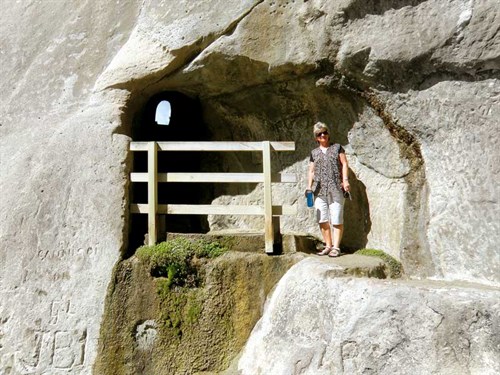
The beach curves for about a kilometre and at the far, north-eastern, end is a rocky promontory, home to fur seals and sea lions.
Yellow-eyed penguins also visit the beach and there is a wooden hide set above the rocks where the public can view the penguins without disturbing them. Unlike the seals and sea lions, they are shy. The return walk is fine until you have to stagger up those steep dunes!
For those who aren’t so keen on walking, the Otago Peninsula has other delights. Probably the most famous is Larnach Castle, New Zealand’s only castle. Unlike nearby sleepy Portobello, the castle does evoke the architecture of Scotland.
Built by James Larnach, a businessman and banker from Australia, over a period of three years in the 1880s (though the interior took another 12 years to complete) Larnach Catle has a chequered history. After Larnach’s death the castle was sold and was later used as a lunatic asylum, a nun’s retreat and a hospital for shell-shocked soldiers. The ballroom was relegated to a sheep pen.
Luckily for visitors the castle was purchased in the 1960s by the Barker family who have returned the derelict and ramshackle building to its former glory. Magnificent gardens have been created by Margaret Barker over the 45 years since the family bought the castle, and are regarded by the New Zealand Gardens Trust as a Garden of International Significance.
At the end of the Otago Peninsula, where the harbour meets the ocean, is the blustery Taiaroa Head. The Head is famous for being the only breeding colony of albatross on an inhabited mainland. The viewing centre offers tours throughout the day where visitors can watch the birds in their natural environment. At dusk there are viewing tours of Little Blue Penguins.
The Otago Peninsula has a quiet, unspoiled feel. There are stunning views, picturesque beaches and an abundance of marine wildlife. A round trip of the Peninsula is about 65kms but beware, there are no petrol stations on the Otago Peninsula.
Further information
There are several camp grounds around Dunedin and on the Otago Peninsula. Freedom camping is generally discouraged on the Peninsula but there are several freedom camping places along the coast road from Brighton to Taieri Mouth.
The Tunnel Beach walk is 2km return from the car park at the end of Green Island Bush Road (off the Dunedin to Brighton Road) and takes 1-2 hours, depending how much time you want to spend on the beach and exploring the arch. It is best to go at low tide. The walkway is closed for lambing from 1 Aug to 31 Oct.
Sandfly Bay is on the Otago Peninsula, 15km east of Dunedin. Seal point Road leads down from Highcliff Road. There is also a marked track which leads from the penguin hides up the side of Sandymount to the car park at the end of Sandymount Road.
Self-contained motor homes can stay on public land and DCC carparks for up to two consecutive nights. There is a campground with campervan sites at Portobello.

